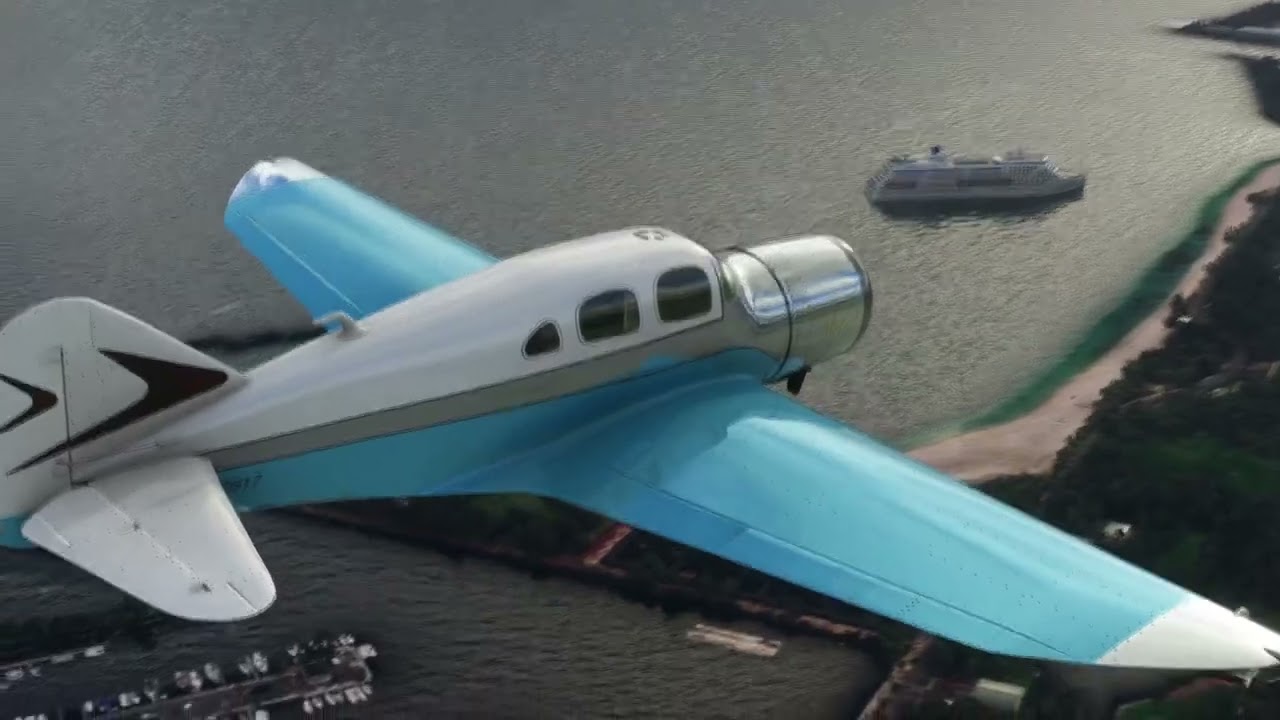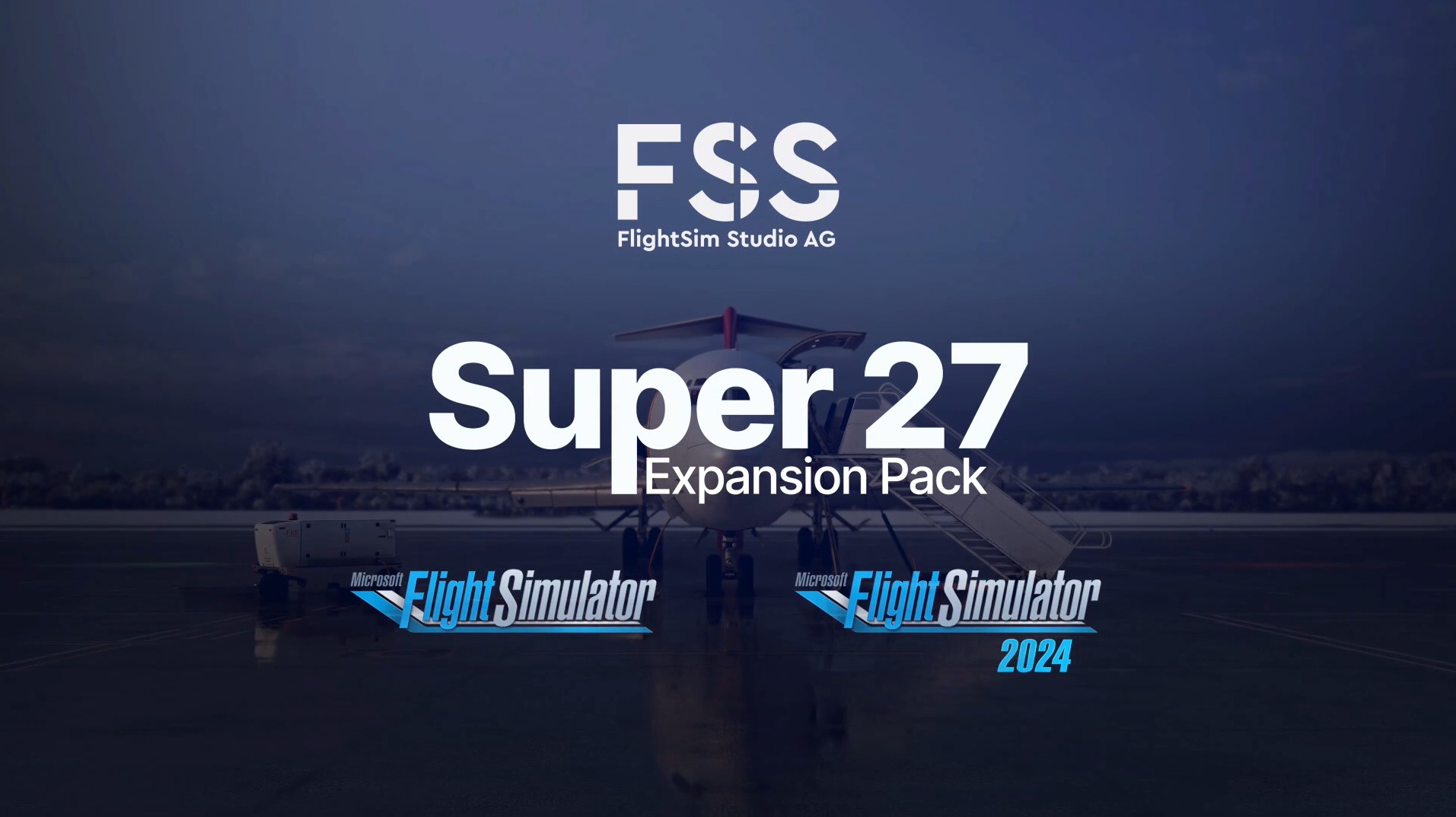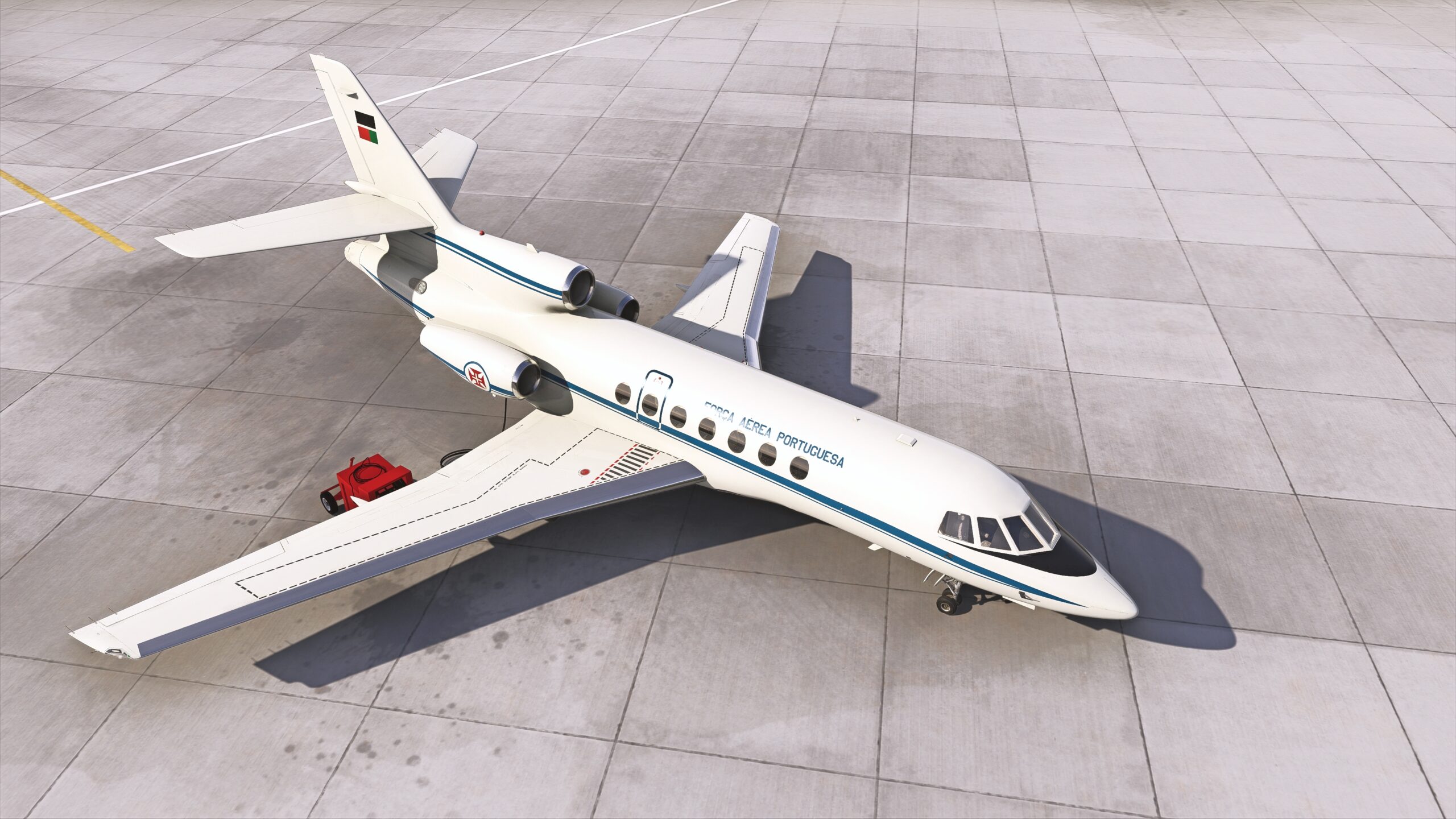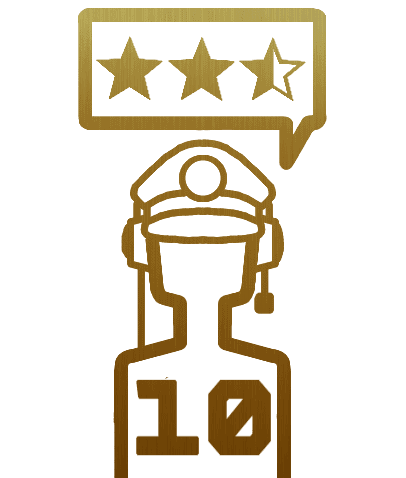The Spartan Executive is an incredible name for a 1930s aircraft dressed to impress. HCG Digital Arts, LTD. has brought those tailored lines into Microsoft Flight Simulator with the HCG Spartan 7W Executive, released in late May. HCG has been in close contact with Jim Savage, a real-world pilot of one of the few remaining Spartan Executives, to create a faithful rendition of the aircraft for MSFS – and the collaboration shows.
Sometimes it feels like flight sim add-ons are “ticking the box” – filling un-claimed gaps in the hangar, being built to cater to a gap in the market not yet covered by someone else. While all the best add-ons are always crafted with a loving hand, it’s rarer to develop an aircraft add-on that few have heard of, in the increasingly competitive add-on category of vintage aircraft. It’s rarer still to do so with as much attention to the source material as was paid to the HCG Spartan 7W Executive – the Art-Deco handful of an aircraft that, while imperfect, impressed me every flight.

HCG Spartan 7W review setup
Before we go back to the Golden Age of Spartan Aircraft, we must first understand the conditions upon which the HCG Spartan 7W Executive was reviewed. For my part, I have been a flight simulator enthusiast since MSFS’ release in 2020, and am training for my U.S. Private Pilot’s License. To compare performance, this product was reviewed on a PC copy of Microsoft Flight Simulator with a Ryzen 5800X3D, NVIDIA RTX 3080, and 64GB of RAM. I sim on an ultrawide 5120×1440 monitor, and used the Thrustmaster Boeing Yoke, Honeycomb Bravo throttles, Thrustmaster TFRP pedals, and Tobii Eye Tracker 5 as peripherals when reviewing this aircraft. All currencies mentioned are in USD. HCG Digital Arts, LTD. very kindly provided a copy for this HCG Spartan 7W Executive review, but the opinions and conclusions expressed herein are my own and not influenced in any way by HCG, Microsoft, or others.
A fine limousine
It’s 1935. Fresh off the heels of the Great Depression, America is healing. Though the specter of war looms over the world, for the moment, times are good. It is now that the Spartan Aircraft Company launches one of the most desirable aircraft ever to grace the Golden Age of Aviation: the Model 7 “Executive.” Designed by James B. Ford, Spartan’s new aircraft was to have a range of over 1,000 miles and a top speed of 200 mph, carrying its lucky occupants in sumptuous comfort.

The first of 34 Spartan “Executive” aircraft first flew on March 8, 1936, as the Spartan 7X. The initial experimental airframe was built with a 260-horsepower Jacobs radial engine, while the eventual production 7Ws were generally equipped with Pratt & Whitney R-985 Wasp Junior engines, producing about 450hp. Each Spartan 7, through all variants, lived its own unique history. While many were indeed sold to corporations as executive aircraft, most served in some capacity during the Second World War. They were often pressed into service as liaisons or training aircraft.
Considering their beautiful, art-deco styling, iconic engines, and association with the golden age of pre-war aviation, it’s no surprise that several Spartan 7Ws were preserved and still survive today. Spartan Aircraft enthusiast Jim Savage, who compiled a history of every Spartan 7 airframe on his website, consulted with HCG to bring the Spartan 7W to MSFS, and stated, “For those of us who own one, it doesn’t get any better.”

HCG Spartan 7W Executive for MSFS: purchase and features
The HCG Spartan 7W “Executive” is available for purchase on simMarket and Flightsim.to for $21.47. As of writing, it is not compatible with Xbox. Installation is handled through each market’s respective means, and I didn’t run into any major control-binding issues. The belly flaps are bound to “Toggle Spoilers,” but everything else worked as I expected for a complex single-engine aircraft.
5 liveries are included, each depicting a real-world aircraft that, to my knowledge, is still flying today. I would highly recommend reading the history of each airframe in the HCG Spartan Executive package. Jim Savage’s extensive research details each individual aircraft, steeping your flights with the HCG Spartan 7W for MSFS in rich history. There is also a canopy cover and tie-downs included, for some extra ramp ambiance.

The manual, tucked away in the install directory, is one of the best I have seen for a vintage aircraft in MSFS. Although it is a little disorganized, it has a wealth of valuable information from primary sources, including pilot reports and reviews from the era, original documentation, and Jim Savage’s own thoughts on flying the Spartan 7W. You won’t find a list of V-speeds or guides to every procedure, but that’s fine. Learning the HCG Spartan 7W is like getting personal, guided instruction from an expert who trusts your skills to put together the missing pieces. If you don’t have those skills, you will develop them very quickly, out of necessity – but we’ll get to that later.
Fine lines: texturing and modeling
Let’s get something out of the way: put the HCG Spartan 7W for MSFS side-by-side with aircraft from the biggest studios in the biz and it’s easy to dismiss the Spartan as just another “mid-tier project” from a small team who can’t match the big boys. But to do so would be to discredit what HCG Digital Arts has done here. Despite any shortcomings, the Spartan 7W for MSFS feels like it belongs in the simulator, amongst its most beautiful scenery. I’m going to point out some specifics, and some issues here and there, but honestly, I don’t think it matters.

External
The real-life Spartan 7W is a beautiful aircraft, with a polished aluminum monocoque and gorgeous, reverse-tapered wing. The HCG Spartan 7W for MSFS is just as handsome, with sleek lines and stunning curvature accentuated by tailored PBR texturing brought to life by MSFS’ engine. Even the liveries without a bare, polished exterior still figuratively shine, because the classic aircraft underneath is so very, literally, breathtaking. Put it in the right lighting and HCG’s work just sings to me – my “MSFS Best Screenshots” folder is now chock-a-block full of Spartan Executive.





Now I do like to get nit-picky in my reviews, so let’s take a closer look. Close the distance and the model begins to show how basic it is compared to some of MSFS’ stronger players. The HCG Spartan 7W Executive is, outside of the main components, generally modeled with simple curves, and often blocky edges. The textures may be 4K, but it’s honestly not always apparent on the outside. We often see developers put special detail into relatively hidden parts of the models, such as wing lights and landing gear, but HCG has opted to keep it simple.





In my opinion, the HCG Spartan 7W is an excellent visual package. What HCG has done is settle on a level of detail, and then execute that well, and consistently. Often, an otherwise good-looking add-on has areas where it is clear that somewhat less effort was spent on the visual artistry – omissions that, once noticed, consistently pull you out of a cohesive experience. The Spartan 7W for MSFS has no glaring flaws, and no pain points to focus on. There is no doubt in my mind that HCG has captured the timeless aesthetic of the Spartan Executive.

Cockpit and cabin
Step inside the HCG Spartan 7W Executive and it’s easy to see Spartan’s goals of luxury realized. Where sleek chrome adorned the outside, the Spartan 7W’s interior is furnished with indulgent leather and plush fabric, and once again HCG has largely executed this well. The blocky corners return in a few places, but they’ve done well to largely keep them out of view while in the left seat. Each livery has its own unique cockpit coloration, which further augments the character of each unique plane.




The cockpit of the HCG Spartan 7W Executive for MSFS features both period and modern instruments, providing a great mix for sim pilots of all skill levels and desire to automate. You get a Garmin GNS530 and KAP140 autopilot alongside what appear to be original engine instruments, and the left side of the instrument panel is an interesting mix as well. I have not been able to find which Spartan 7W cockpit HCG has modeled their layout on. The “six-pack” is all present, but from all the photos I can find, most flying Spartans are either completely modernized (as Jim’s example is, with things like an HSI and a more typical layout of secondary instruments) or left in a period state, with little to no modern instruments, in potentially awkward layouts.





This mix of old and new is somewhat exciting, and it is certainly more deliberate than some add-ons where a modern GPS is just tacked on to a blank spot in the panel to appease customers who want convenience. The modern instruments are logically added, but the cockpit retains the vintage aircraft charm. There are a few items that fall flat, however; such as many of the toggle switches, colored lights, and circuit breakers. Here, the simplistic models and textures are more noticeable since you stare at them all flight, but the HCG Spartan 7W still delivers a good overall result.
In-sim performance of the Spartan Executive was excellent. As a relatively simple aircraft, I expected it to be smooth and it delivered. This is especially important since I like to use my eye tracker with GA aircraft, and the HCG Spartan 7W was great in this regard.
The Sound of Silence Sparta
I have gone a little batty chasing the perfect classic radial engine sound in Microsoft Flight Simulator. The HCG Spartan 7W Executive for MSFS includes a brilliant set of engine sounds that come so close to scratching this itch. In some ways, the Spartan 7W has presented the best P&W Wasp Junior I have heard yet – but in others, I remain disappointedly searching.
First, the engine sounds are clearly accurate. Videos of Spartan 7W Executives at airshows and private fields sound largely the same, and the throaty, ragged growl of the R-985 is captured effectively. At idle, it gulps and churns in cycles, smoothing out with increased power before climbing to a roar on takeoff, purring contentedly in cruise. I would highly recommend a pair of headphones to experience the HCG Spartan 7W’s sounds to their fullest, as the full range of sound was lost on my desktop speakers.

But the sounds are not perfect, and it’s a real shame when the issues present themselves. When you first start the engine, the recorded audio sequence sounds like it is playing back through a speaker in the cockpit, before abruptly fading into the idle sound set – that is, it does not feel like it is emanating from the same engine that sits in front of you. The audio loops are either too short or inexpertly cut, and it is easy to discern where the loop repeats. While the engine itself sounds largely great (despite the issues), cockpit sounds for switches, flaps, and gear do not sound like they were produced to the same standard. It’s as though I am listening to the engine through my studio headphones, and the rest through a pair of cheap earbuds.
Sound examples
Please, ignore the multiplayer-isms. Any stuttering in the videos is the fault of the recording/replay software, not the sim or HCG Spartan Executive – both of which were excellent.
An executive handful
Flying the HCG Spartan 7W Executive is exhilarating. It flies like you would expect a luxury aircraft of the 1930s to fly: fast and comfortable during the cruise but with considerable airmanship demanded during takeoff and landing. The manual included with the Spartan Executive for MSFS has a detailed pilot report from 1939, as well as Jim Savage’s own experience, and both paint a very detailed picture of how the aircraft should fly.

I am pleased to say that my experience with the HCG Spartan 7W largely matches the reports laid out in the manual. It is powerful, even loaded down, and at sea level can easily achieve astonishing rates of climb. At the high-altitude airports in Colorado, it still maintained a sufficient rate of climb to navigate the mountains with ease, though engine power did begin to drop off rapidly above 10,000 feet, mostly affecting the cruise speed, which settled between 160-190KIAS depending on altitude, neatly matching the cruise speeds listed in the manual.
It is docile and responsive, with easy-to-coordinate turns. Like many aircraft in MSFS, it is extremely sensitive to pitch trim but once it’s trimmed it settles nicely into climb or level flight. Pilots of the time reported a surprising lack of left-turning tendencies, an uncommon characteristic for a powerful single-engine piston aircraft, and that is reflected in HCG’s rendition as well – only slight right rudder pressure is needed during a steep climb. The HCG Spartan 7W is quite stable, but you do still get thrown about in bumpy weather. This is definitely a fair-weather cruiser, for after all, what good does it do if no one can see how beautiful the plane is?




Tail draggers and eye trackers
As is typical of tail-dragger aircraft in Microsoft Flight Simulator, the HCG Spartan 7W requires some special skill to take off and land properly. Turn authority on the ground is quite sensitive, in part due to the steerable tailwheel with no tailwheel lock. Often during mid-speed taxi, I found it “safer” to use very light differential braking rather than rudder/steering to stay on the centerline, lest the aircraft very quickly develop a ground loop.



However, it is hard to fault HCG in any way here – tail-dragger aircraft require special training to operate in real life, and MSFS’ ground handling model has never treated them particularly well. I have also never loved using my eye tracker as much as I have with the HCG Spartan 7W for MSFS. The nose is gigantic and completely blocks your typical field of vision. HCG has not included a “taxi camera” position by default, so my solution to the visibility problem was to actually roll down the window and lean my head out the side, in a wonderful bit of immersion.

The HCG Spartan 7W Executive, much like the real thing, develops a huge amount of drag in landing configuration. With gear & flaps out and prop full fine, the Spartan 7W can achieve descent rates in excess of 1,000fpm at approach speeds even with some power still in. I think that the drag might be slightly excessive, but if you follow a steeper approach path than normal you can still achieve the numbers mentioned by Jim Savage in his approach notes.

Just beware of low-speed flight: The HCG Spartan 7W drops a wing nastily in a stall, and ailerons are ineffective when this occurs, rapidly developing the stall into a spin. With so much drag, it’s best to come in slightly steeper and faster than you might be used to in a typical traffic pattern. HCG has released one update since release that did significantly improve handling, but on touchdown, you still need a deft hand & foot on the controls to avoid a ground loop. The airplane will nose-over aggressively with a light back seat and too much braking (true to life!), so it’s a delicate dance to keep the nose level for visibility while slowing to a more easily controllable ground speed.
Systems and engine model
The HCG Spartan 7W for MSFS has a very standard set of avionics and systems, and these are all generally executed well. The basics are all present, with navigation working well on either VOR or GPS, fuel burn generally seeming to match the stated endurance numbers, and no issues when switching tanks using the proper procedure. This is a simple engine model and has no wear & tear included. Likewise, there is no drama with the engine start – fulfill the right conditions, and the engine fires right up with no consideration needed for managing temperatures & pressures or working the throttle & mixture to start up on cold days.
Curiously, the Engine Start button is only functional the first time you start the engine on the ground – if I cut the fuel in flight or want to perform a turnaround, I could not restart the engine because the starter would not respond to my clicks. We reached out to HCG about this (and some other bugs, which we will address in a moment) and they stated this was a deliberate choice. I admit it is one that I do not agree with, but can respect it nonetheless. If you do need to restart your engine for any reason, the Quick Start (Ctrl+E) binding works just fine.
All the circuit breakers on the panel are functional. Most of them correctly fail the related system when pulled; however, I did notice some inconsistent behavior with the flaps circuit breakers, the breakers for the landing light motors, and a couple of others. This is nothing major, as you won’t be pulling breakers in flight. I really like the inclusion of functional breakers on the HCG Spartan 7W, and having a few oddities or non-functional items does not make or break it for me.

Minor bugs
There are a few bugs I’d like to mention in this HCG Spartan 7W for MSFS review. Besides the minor issue(s) with the circuit breakers mentioned above, the belly flaps operate even if the aircraft is de-powered. Although most early Spartan 7Ws were built with pneumatic flap systems, HCG confirmed that this is a bug, and their rendition models an aircraft with retrofitted electric flaps. HCG did commit to addressing all the bugs that we brought to them in a future update.
The only other bug I noticed with the HCG Spartan 7W is the turn coordinator. The ball correctly moves, but the miniature airplane never banks beyond approximately a half-standard-rate turn. Overall, the HCG Spartan 7W is done to a very reasonable level of polish – certainly excellent for a development studio as small as HCG Digital Arts, LTD. There were a few other minor bugs in the initial release version, but HCG updated those quickly and sent us an updated copy mid-review, so it’s not worth mentioning any that I experienced before the update.
Conclusion
I mentioned in the introduction that the HCG Spartan 7W Executive does not fill a gap in your hangar. There are other vintage executive aircraft, some with radial engines and around the same time period, that you would also have fun cruising around in. And we have seen throughout this Spartan 7W review that it’s certainly not perfect, and it does not deliver a deep, nuanced simulation experience for people that care about things like perfect engine modeling.
I would understand if you have another vintage luxury aircraft that you already enjoy and don’t see a spot for the Spartan 7W in your fleet. I would also understand if you’re looking for a more temperamental engine or an aircraft that you can practice emergencies in with perfect systems response. But I would still encourage you to give the HCG Spartan 7W Executive for MSFS a good, long look. It is well-priced, and I would be confident that you would enjoy flying it.



To me, the Spartan Executive feels right for certain flights in a way that aircraft rarely do. Cruising from Sedona to the Grand Canyon or from the red rocks of Moab to the glass canyons of New York City, I realized that while I had other options, I preferred to fly these routes in the HCG Spartan 7W Executive. It’s hard to look at a screenshot and argue that it doesn’t look like a blast, listening to the engine purr while sitting back in your comfortable seat, watching the world go by underneath.
HCG’s achievement is buoyed by the reverence that they obviously have for the source material. The Spartan 7W Executive is a great target for a classic aircraft to bring to the sim since there are (relative to other vintage designs) so many of them still flying and preserved. HCG’s dedication to consistency in modeling, hitting the performance numbers, and tweaking the flight model to match the experiences of pilots both from the 1930s and 2020s has paid off as handsomely as the aircraft they’ve chosen to make. As was stated before: “For those who own one, it doesn’t get any better.”

Feel free to join our Discord server to share your feedback on the article, screenshots from your flights or just chat with the rest of the team and the community. Click here to join the server.













